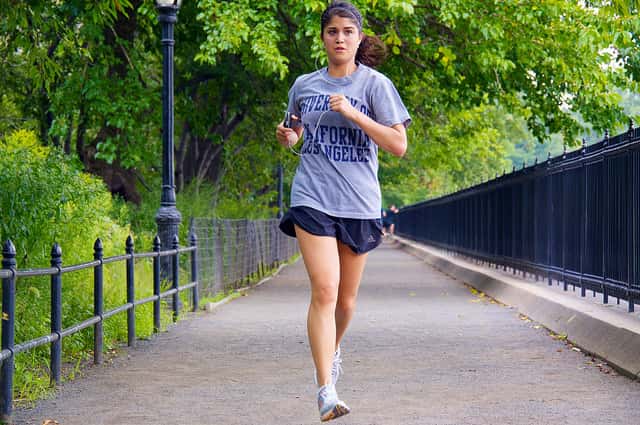Feeling a bit puzzled about how to fuel up while training for a half marathon? Then you’re in the right place.
Let’s lay it down straight: Nutrition isn’t just a part of your half-marathon training; it’s the backbone of it. Imagine setting out on a road trip with an empty gas tank—sounds like a no-go, right? That’s exactly how crucial the right nutrition is for your running journey.
Despite its importance, nutrition is often pushed to the side. Many of us focus on the miles and forget about the meals.
But fear not, I’m here to change that.
In this guide, I’m diving deep into the world of half marathon nutrition, unpacking my top tactics and strategies to ensure you’re not just well-fueled but primed for every run. From optimizing your calorie intake to understanding the best foods for endurance, consider this your roadmap to a well-nourished, successful training and race day.
Sounds like a great idea?
Then let’s get started.
Nutrition Basics for Runners
Navigating nutrition as a runner is crucial. Each nutritional element plays a vital role in fueling sprints to marathons.
Let’s dive into the essentials of runner’s nutrition.
Caloric Needs:
Your calorie needs are as unique as your running route. They’re influenced by a mix of factors including the intensity of your training, your metabolism, body size, and overall activity level. Getting a handle on your specific calorie requirements is crucial for keeping your energy up and recovery swift.
Carbs: The Runner’s Premium Fuel
Carbs are the stars of the show in a runner’s diet, breaking down into glucose to fuel your muscles during those long runs. They’re your high-octane fuel, ensuring you run smoothly mile after mile. After your run, carbs are essential for topping up your glycogen stores, prepping you for your next workout. Stick to complex carbs for that slow and steady energy release, giving you lasting power.
Proteins: The Muscle Menders
Proteins step up to repair and strengthen your muscles after the rigors of running. A steady intake of high-quality protein aids muscle recovery. Lean meats, fish, eggs, soy, and Greek yogurt are your allies, providing the necessary support for your muscles to rebuild and grow stronger.
Fats: The Endurance Enhancer
Fats often get a bad rap, but for endurance runners, they’re invaluable. Offering slow-burning energy for those longer distances, fats are essential for vitamin absorption and maintaining healthy cells. Healthy fats from avocados, nuts, seeds, and fatty fish not only support your long runs but also contribute to hormone balance and cellular health.
Dialing In Your Pre-Training Nutrition
Setting the stage with the right pre-training diet is a game-changer. Your pre-run nutrition can significantly affect your energy levels, endurance, and comfort. Here’s how to fuel up right:
- Focus on Carbs: Your pre-run meals should be rich in carbs but low in fat, fiber, and protein to avoid any digestive discomfort. Carbs are your quick-to-access energy source, ready to power your run from the get-go.
- Timing Your Meals: Eating a full meal 2-3 hours before running ensures your body has time to digest and convert food into energy. It’s about making sure you’ve got the fuel ready when you hit the road.
- Last-Minute Fueling: For those runs that pop up with little notice, opt for a light snack 30-60 minutes beforehand. This acts as a quick energy boost, priming your body for the effort ahead without overwhelming your digestive system.
Meals for 2-3 Hours Before Running:
For a quick but energy-boosting breakfast, try oatmeal with bananas and a drizzle of honey, or whole-grain toast with a smear of almond butter. These meals provide a solid carb foundation with just a hint of protein and fats.
As for dinner, experiment with a modest portion of rice with some steamed vegetables or a simple turkey and cheese sandwich on whole-grain bread can offer the right nutrient balance without making you feel sluggish.
Snacks for 30-60 Minutes Before:
Right before you head out, a banana, an apple, a handful of raisins, or a rice cake with a bit of jam can give you that quick energy boost. Think of these snacks as the nutritional equivalent of stretching your legs before the race—necessary, beneficial, and preparatory.
Eating During Long Runs
If you’re gearing up for a long run, picking the right snacks to keep you energized is crucial. Whether you’re all about the ease of store-bought snacks or you’re into whipping up your own fuel, the aim is to find what keeps you going strong.
Here’s a rundown on some top choices for mid-run munchies:
- Gels, Jellies, and Sport Beans: These little packets are carb bombs, usually packing about 25-30 grams of carbohydrates. Some come with extras like caffeine or electrolytes, giving you an additional energy kick and helping with hydration.
- Sports Bars: For a more satisfying snack, sports bars are the way to go. They typically have a mix of carbs and protein, making them ideal for those longer stretches when you need something a bit more substantial.
- Fig Bars: Homemade or store-bought, fig bars are a sweet, convenient option. They’re loaded with natural sugars and are super easy to pack, providing a tasty mid-run fuel source.
- Peanut Butter and Jelly Sandwich: The good old PB&J sandwich, squished into a zip-lock bag for easy transport, is a fantastic blend of quick and slow-releasing energy. Plus, it’s a nostalgic nod to simpler times that tastes great even on the run.
- Pretzels: If you’re in the mood for something salty, pretzels could be your go-to. They offer carbs and a sodium hit, which is perfect for replenishing what you sweat out during those miles.
Here’s what to eat at night after a workout
Hydration Strategy
I know, I know, you’ve heard it all before. But truly, staying well-hydrated is the secret sauce to keeping your body running like a well-oiled machine.
Here’s a straightforward plan to ensure you’re optimally hydrated before, during, and after your runs, making every drop count.
- Start Your Day Right: Begin with a glass of water as soon as you wake up. Keeping your hydration levels steady is key; it’s much simpler to stay hydrated than to play catch-up later.
- Pre-Run Prep: 2-3 hours before your run, aim to drink 17-20 ounces (500-600 ml) of water. Think of it as laying the groundwork for what’s ahead.
- Last-Minute Top-Up: 20-30 minutes before heading out, have another 8 ounces (about 240 ml). This is your final systems check.
- Hydration on the Move: Try to consume 7-10 ounces (200-300 ml) of fluid every 10-20 minutes during your run. Tailor this to fit the day’s conditions, your personal sweat rate, and hydration needs.
- Electrolyte Intake: If you’re running for more than an hour or it’s particularly warm, weave in a sports drink with both electrolytes and carbohydrates. Electrolytes are the unsung heroes, ensuring your nerves and muscles function seamlessly.
- Know Your Sweat Rate: Understanding your sweat rate can be a game-changer. Weigh yourself before and after a run to calculate how much fluid you’re losing. It’s like monitoring your car’s fuel consumption for the most efficient refill strategy.
- Rehydration Goal: Post-run, aim to replenish 150% of the fluids lost during exercise over the next few hours. For instance, losing 1 kg during your run means you’ll need to take in 1.5 liters of fluid for complete rehydration.
- Urine Color Check: Keep an eye on the color of your urine as a quick and easy hydration gauge. You’re aiming for a pale yellow color, akin to lemonade. It’s your body’s intuitive way of indicating its hydration level, similar to a dashboard warning light signaling when attention is needed.
By adopting this hydration strategy, you’re setting the stage for enhanced performance, recovery, and overall well-being during your running journey. Remember, every sip counts towards keeping you at the top of your game.
Post Run Eating
Post-training diet is crucial for your recovery, much like how cooling down and stretching are after a run. It’s about getting the right mix of fluids, electrolytes, calories, carbs, and proteins soon after you finish to kickstart the recovery process.
Skipping on post-run nutrition is like skipping on your cool-down; it can slow down muscle repair, energy replenishment, and overall recovery.
Getting your post-run fuel right not only helps your muscles recover but also prepares you for the next workout.
Sports nutritionists often suggest a carb-to-protein ratio of 3:1 to 4:1 for your post-run snack or meal, aiming for about 20 grams of protein.
For carbs, the go-to amount is 0.6-1.0 g/kg of your body weight right after your run, continuing to refuel every couple of hours for the next 4–6 hours.
While there’s no universal macronutrient ratio that fits every half marathoner, a common guideline is to aim for about 55% of your calories from carbs, 25% from proteins, and 20% from fats. Remember, though, your specific needs might vary depending on how much you train, your weight goals, and what you like to eat.
Looking for a nice couch to half marathon plan? Check my guide here.
The Best Time for Post-Run Nutrition:
There’s a ‘golden window’ of about 30 minutes after your run when your body is especially ready to soak up nutrients. Taking advantage of this window jump-starts your recovery.
Following this with a more substantial meal a few hours later ensures you’re fully supporting your body’s repair and recovery processes, acting like a comprehensive maintenance check following the initial quick fix.
Here are a few snack ideas:
- Smoothie with yogurt and fruits: A blend of dairy or plant-based yogurt with your choice of fruits offers a perfect mix of proteins and carbs for immediate recovery.
- Banana with peanut butter: This classic combination provides a quick carbohydrate replenishment with a protein boost.
- Handful of nuts with dried fruits: Offers a balance of healthy fats, protein, and quick sugars for recovery.
Here are a few quick post-run meals to kick off the recovery process:
- Grilled chicken with quinoa and vegetables: A balanced meal providing lean protein, complex carbs, and essential nutrients.
- Hearty lentil soup with whole-grain bread: A comforting option that delivers protein, fiber, and carbs.
- Salmon and avocado salad: This meal combines high-quality protein, healthy fats, and a variety of vitamins and minerals.









